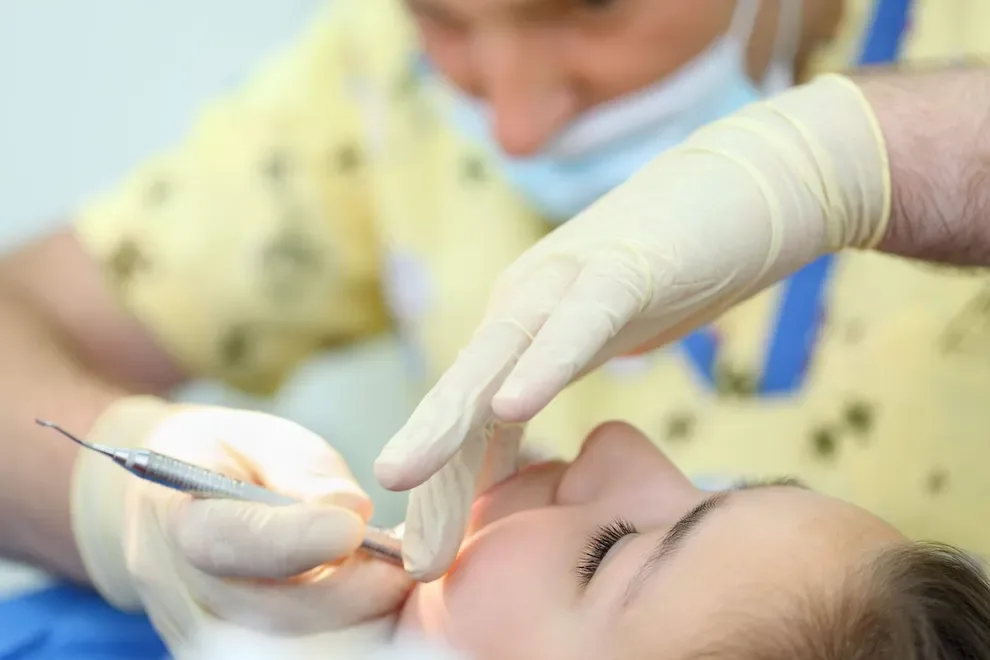What Are Odontomas and How Are They Treated?

Table of Contents
- Types
- Signs & Symptoms
- Diagnosis
- Odontoma Removal (Before, During & After)
- Outcomes
- References
Odontomas are common, non-cancerous tumors connected to the development of teeth. They are made of soft and hard dental tissue components, including pulp, enamel and dentin, and they often interfere with the normal development of your teeth.
The benign tumors comprise an abnormal collection of dental tissues and cells that invade the jaw around your teeth in the jaw while others erupt into your oral cavity. Overall, they account for about 20 percent of odontogenic tumor cases worldwide, and the average age at which they are detected is 14.
In the mouth, odontomas appear as an oddly shaped tooth or small or massive calcified tumor. Treatment of them is straightforward: they must be removed.
Types
There are two main types of odontomas – compound tumors and complex tumors.
Compound Odontomas
Compound odontomas are usually numerous tooth-like structures known as denticles. They commonly occur in your lower jaw and measure about 20mm in diameter. They are often detected during your teenage years and affect men and women equally. Cases of compound odontomas are twice as common as complex ones.
Complex Odontomas
Complex odontomas are irregularly shaped masses of soft and hard dental tissues that don’t resemble your teeth. They consist of a mixture of dental tissues, namely, dentin, enamel, and cementum. They usually occur in your 20s and are often found in your upper jaw, especially where there is a missing tooth. Similar to compound odontomas, complex odontomas affect men and women equally.
Signs and Symptoms
Odontomas are typically asymptomatic and are often discovered during a dental radiological examination. However, various dental anomalies in younger people between the ages of 20 and 30 can indicate an odontoma. These include:
Persisting deciduous tooth
Missing or impacted permanent tooth
Delayed tooth eruption
In certain cases, an odontoma may erupt into the oral cavity, exposing the tumor through the gingival mucosa. In such cases, your odontoma could cause:
Swelling of adjacent soft tissues
Pain
Discomfort
Infection associated with suppuration
These signs could indicate the presence of an odontoma. Also, about 80 percent of people with odontoma have teeth that haven’t erupted.
Diagnosis
Early diagnosis of an odontoma is important, especially during your first decade in life when orthodontic treatment is needed. This is because odontoma usually creates a barrier that prevents the eruption of teeth. Early removal of odontoma can help your impacted teeth to erupt, eliminating the need for surgical-orthodontic treatment.
Clinical diagnosis of odontoma can be confirmed through histological examination. Routine radiography performed by your dentist can also help detect a developing odontoma. An X-ray is important in identifying a growing odontoma because it usually develops internally around your teeth, making it difficult to detect.
Differential diagnosis can help identify the type of odontoma you may be having. Typically, the shape of your tumor can help your dentist determine whether it’s a complex or compound odontoma.
Complex odontomas are usually disordered messes, while a compound odontoma appears more organized and often resembles normal teeth structures. Complex types also have a dense body and usually develop at a younger age, making them easily differentiated from compound odontomas.
About Odontoma Removal (Before, During, and After)
If you’re diagnosed with odontoma and it’s causing you pain or if it’s interfering with the natural eruption of your teeth, surgical removal is the tried and proven treatment. The best thing is that once it is removed, there is little to no probability of recurrence.
Here’s everything you need to know about your odontoma removal before, during and after surgery.
Before your odontoma removal surgery:
Vital parameters are recorded, including arterial blood pressure, heart rate, peripheral capillary oxygen saturation, and height and weight.
Your maxillofacial surgeon examines the permanent teeth adjacent to the odontoma to ensure their roots are about one-half developed. This helps ensure the safety of your permanent teeth and their normal eruption.
Discuss with your oral surgeon if you need a tooth extracted or any alignment issues.
Local anesthesia is induced before the extraction of your odontoma.
The surrounding epithelial tissue comprising mucoperiosteal flap is enucleated to reveal the tumor, curettage, and the overlying bone. The odontoma is then extracted the overlying bone is necessary using a high-speed handpiece.
The odontoma tumor is then submitted for histopathologic evaluation.
Large lesions may need adding bone to fill the defect. However, bone grafting may not be necessary if the cavity is small and the surrounding bone is intact.
The surgical wound is then sealed using a resorbable suture.
After the odontoma is extracted, the unerupted tooth could be removed if it's not developing correctly.
Your doctor may recommend post-operative clinical and radiographic observation.
After surgery, your dentist may recommend the following to help you heal:
Antibiotic medication
Pain relief medication
Opening your mouth minimally
Not to engage in any physical exercise for the next 48 hours
Observing proper oral hygiene
Taking only cold and soft meals
If you’re diagnosed with odontomas, the best treatment is surgical removal using local excision. This will help ensure they don’t recur.
Outcomes
Following your post-operative instructions will increase your chance of getting a satisfactory outcome in terms of appearance and periodontal status. A periapical radiograph should reveal good bony healing around the operated region.
Because odontomas are asymptomatic, it’s crucial to see your dentist regularly so they can take X-rays and examine you properly to identify the odontomas as early as possible.
